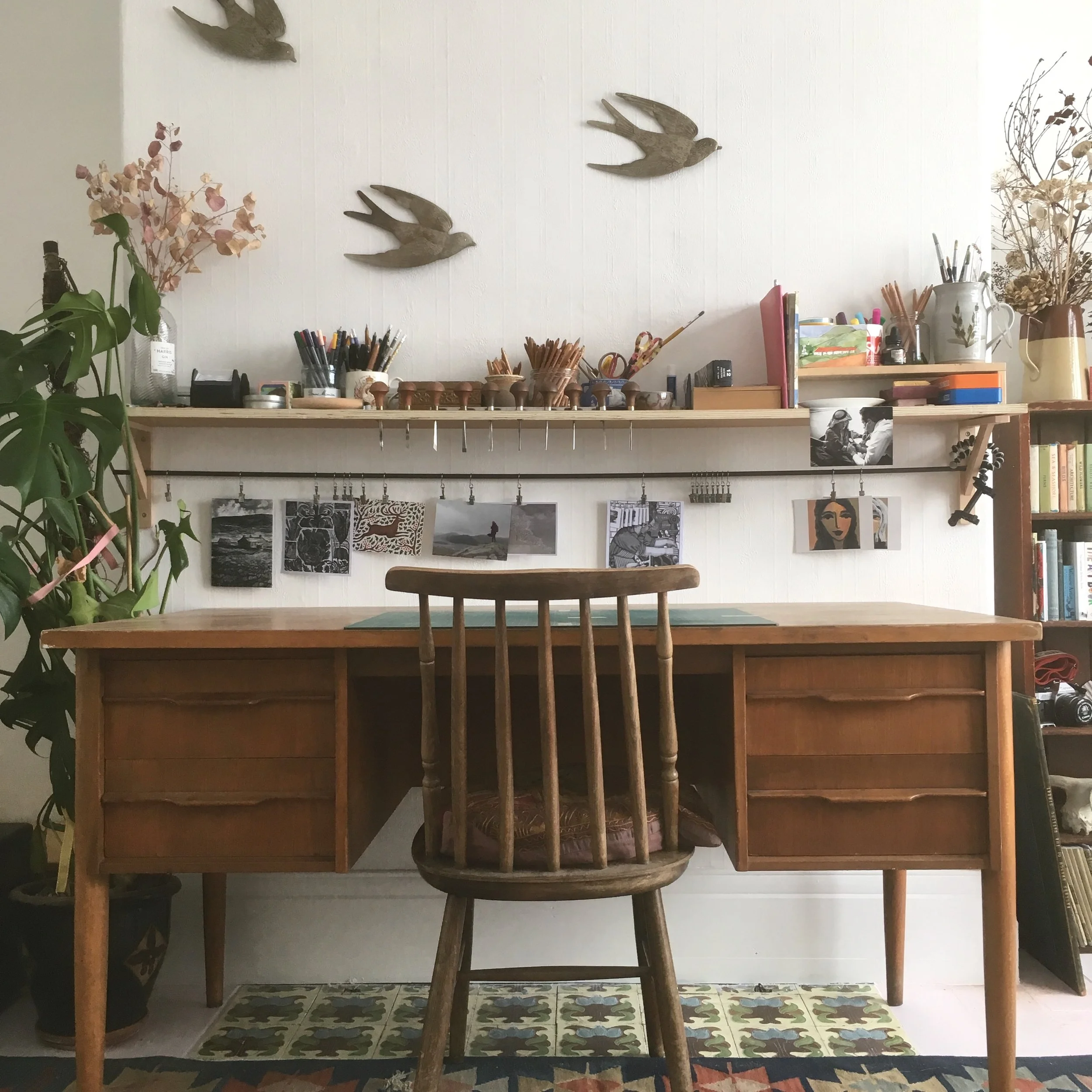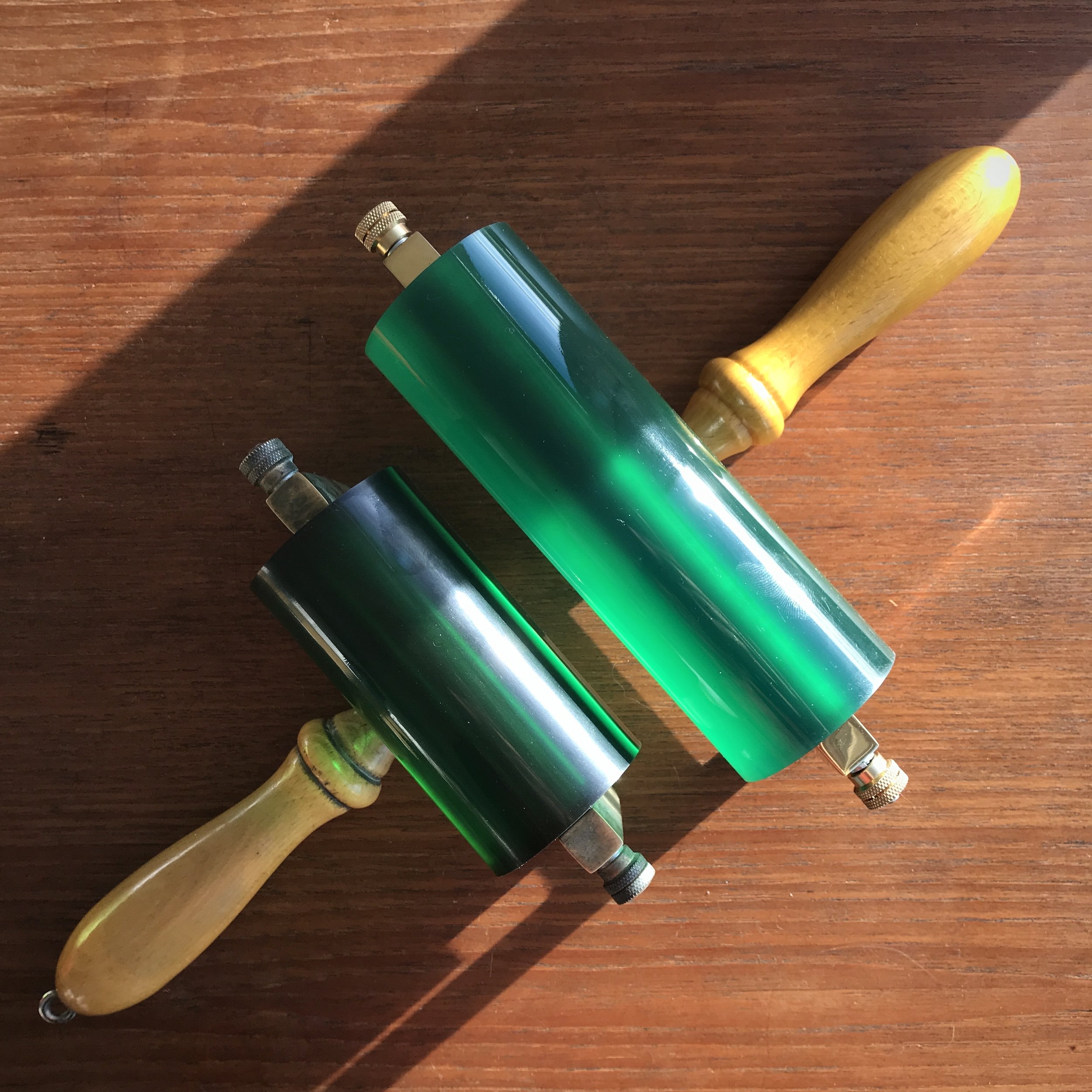Studio and Practice
I worked from home before everyone was doing it. I made my first ever linocut in 2009, teaching myself the basics through guesswork on a moving train between Newcastle and London. I still have all of my fingers. In those days my studio was my kitchen table, with a wicker basket to sweep everything into for meals, but I’ve had a proper studio space to call my own since 2016. A lot of my tools and equipment have been upgraded since the kitchen table days too, though I still use the same wooden spoon to pull all of my prints.
I’m a messy worker, and I seem to see clear surfaces as a challenge. A year of homeschooling has also done my studio no favours, and it’s currently more cluttered than ever, with our homeschool class table and two non-functional DIY printing presses. I dream of a single Albion platen press, clear floors and a place for everything, but I doubt any of those things will happen in my lifetime.
The consolation of a messy existence is that I’m never worried about making it even worse. A print idea very rarely lands neatly in my sketchbook, and I’ve almost always got loose bits of paper, books, odd sketches, tester bits of lino, pens, pencils, mugs of coffee (black, no sugar) and tools scattered everywhere. I find that so many things give me inspiration or ideas, and if I don’t put them where I can see them then I forget.
Pre-pandemic, my practice was based largely outside my studio. I’d head off into the hills and woods around my house in rural Northumberland, take lots of photos, do some drawings, collect interesting sticks, leaves, shells and stones, then bring it all home to work up into a print. Sometimes I even managed to go further afield, and I’d travel, finding inspiration wherever it found me. I looked a lot at the landscape as a whole: at crashingly dramatic seascapes and plunging fells.
I have always been drawn to liminal spaces: the uninhabitable, the wild, rugged and windswept places, where I can be alone with the sound of silence, birds and weather. I love the Cumbrian fells in bad weather, the west coast of Scotland, as well as the Highlands and islands. I love to explore the places and landscapes where living must be hardest, to find small moments of light and life which make the hard slog to get there worthwhile. The memories I capture are things I want to take home with me, and to share with everyone who wasn’t there. As often as I can, I will pack my sketchbook and my full drawing box into my van, and head out to draw. Increasingly I find I leave my camera at home.
Since the pandemic I have felt more like looking inward for inspiration, and people have appeared more commonly in my prints. Likewise, domestic scenes blossomed for me when there was no hope of leaving my home except for my daily exercise. I can no longer find the same sense of awe I used to feel for a large landscape, but instead I am more likely to be drawn to something almost insignificant, but beautifully formed, like a single plant growing out of a wall, or the way the low autumn sun gives dying foliage a halo of light. I think the pandemic has forced me to slow down, and to take a more considered, less monumental approach to my practice. I am content to occupy this space, and open to any change which comes my way.
A recent move to Orkney in April 2022 has opened up new horizons and views which I intend to explore fully.
In my studio I have built up a nice range of tools over the years. One of the things I am asked most is how to get started in linocut, and I am then reminded about how far I’ve come. When I began making prints, my studio was:
1 cheap red plastic handled linocutting tool with interchangeable blades (10 gouges)
1 small red plastic roller
2 tubes of water based block printing ink (proof indeed that I didn’t know what I was doing)
1 piece of knackered perspex for rolling out ink
1 wooden spoon, recently pinched from the kitchen drawer
Newsprint
Lino (I first bought softcut but very quickly migrated onto proper grey battleship lino)
That is honestly all you need to get started making linocut prints. If your time, space or budget are as limited as mine was, start there, and collect things gradually. I found what I needed and what worked for me as I went along. I also found out what didn’t work for me (hello, water based block printing inks) and now my kit is a lot more sophisticated, wide ranging, but most importantly, it suits me and my practice.











